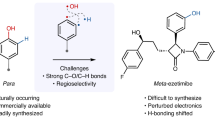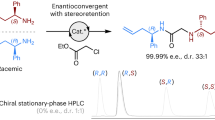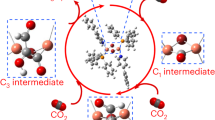Abstract
The rapid assembly of complex scaffolds in a single step from simple precursors identifies as an ideal reaction in terms of efficiency and sustainability. Indeed, the direct single-step synthesis of complex alkaloid frameworks remains an unresolved problem at the heart of organic chemistry in spite of the tremendous progress of the discipline. Herein, we present a broad strategy in which dynamically assembled ternary complexes are converted into valuable azabicyclic scaffolds based on the concept of inverse hydride shuttle catalysis. The ternary complexes are readily constructed in situ from three simple precursors and enable a highly modular installation of various substitution patterns. Upon subjection to a unique dual-catalytic system, the transient intermediates undergo an unusual hydride shuttle process that is initiated by a hydride donation event. Furthermore, we show that, in combination with asymmetric organocatalysis, the product alkaloid frameworks are obtained in excellent optical purity.

Similar content being viewed by others
Main
Contemporary organic synthesis aims to further our understanding of nature by developing laboratory routes to molecules that mimic those produced by living organisms with ever-increasing levels of complexity. The ideal synthesis of a target compound is most often described in terms of the number of synthetic operations required to reach said product—with ideality lying as close to one single step as possible1. Due to their modular nature and their ability to rapidly generate multiple new bonds, multi-component reactions often equate with highly efficient syntheses2,3; however, it is notoriously difficult to design multi-component reactions leading to valuable targets. In particular, we believe large untapped potential exists in dynamically assembled complexes, formed under equilibrium, that preorganise multi-component arrays of reactants (Fig. 1a). Converting these complexes into templates for the deployment of catalytic methods offers a challenging but potentially rewarding avenue towards highly complex products4,5.
a, Dynamically assembled complexes with unexploited synthetic potential: reversible preorganisation into ternary complexes and interrogation of routes able to convert the ternary complex directly into a complex scaffold. b, Azabicycles in natural products and pharmaceuticals. HCV, hepatitis C virus; GABA, γ-aminobutyric acid receptor. c, Azabicycles are formed in a single step, enabled by inverse hydride shuttle catalysis starting from ubiquitous starting materials. Fleeting cyclobutene intermediates are converted into complex frameworks with up to 99% yield, forming up to four new stereocentres with excellent enantioselectivity (up to 99% e.e.). EWG, electron-withdrawing group.
Alkaloids remain a highly prized and elaborate subset of natural products and drug candidates6. Azabicyclic alkaloids, structures where two fused rings share a nitrogen atom, are prevalent throughout nature with potent and diverse biological activities (Fig. 1b)7. Indeed, over 1,800 secondary metabolites contain the indolizidine core, and more than 2,000 naturally occurring pyrrolizidine and quinolizidine derivatives are known8. While synthetic chemistry has risen to the challenge of preparing such targets in the laboratory, their complexity still renders such efforts as multistep endeavours9,10,11,12.
Herein, we report the one-step, multi-component conversion of bulk chemicals (cyclic amines, electron-deficient olefins and aldehydes) into complex bicyclic alkaloid scaffolds via inverse hydride shuttle catalysis (so termed because it is initiated by a hydride donation event rather than an abstraction event)13,14,15,16. This asymmetric transformation harnesses dynamically formed complexes that assemble the precursors and forges valuable products carrying up to four new stereocentres with excellent enantio- and diasteroselectivities, in a synthetically ideal manner (Fig. 1c).
Results and discussion
Interested in leveraging skeletal reorganisation of reversibly assembled, dynamic complexes formed by a multi-component equilibrium process, we turned to the reversible addition of enamines to Michael acceptors, known to transiently generate fleeting donor–acceptor cyclobutanes17,18,19,20, and explored a range of sterically constrained, boron-based Lewis acids to evoke a formal ring expansion (Table 1). Interestingly, B(C6F5)3 1a—a commonly employed Lewis acid21,22,23,24—failed to provide the desired product, returning only unreacted starting material. At the opposite end of the Lewis acidity scale, Ph3B 1e similarly did not lead to the formation of any observable product. Given that boron-based Lewis acids at both ends of the Lewis acidity scale had given poor results, it was clear that careful tuning of the electronic properties of the Lewis acid was required. We thus found that stoichiometric amounts of tris-(2,6-difluorophenyl)borane 1c (refs. 25,26) can promote the desired skeletal rearrangement. Converting this process into a catalytic variant (Supplementary Section 2 for details) required the combination of catalytic quantities of both Lewis acid 1c and its preformed tetraalkylammonium hydride 1c–H.
Several complex azabicyclic structures are accessible through this transformation. As shown in Table 1, bicyclo[4.3.0], –[4.4.0] and –[5.4.0] systems can be prepared in a single step, affording the products as single diastereomers featuring three contiguous s tereogenic centres (5a–5c). The use of fused-ring reactants (5d and 5e), as well as the introduction of additional substituents, allows a rapid increase in the complexity of these alkaloid-like products (5f and 5g). Acyclic secondary amines were also amenable to this method, leading to multi-substituted piperidine derivatives (5h). While the use of linear aldehydes enables the diastereospecific formation of azabicyclic cores carrying an additional stereogenic centre (5k), employing cycloalkanecarbaldehydes readily affords spirocyclic structures (5l). We were pleased to find that the efficiency of the reaction is not adversely affected by the electronic nature of the nitroolefin: electron-donating (5n–5p) or electron-withdrawing (5q–5t) groups are well tolerated, as are heteroaromatics (5u–5w) and alkenyl (5y) and alkynyl (5z) substituents.
Performing the reaction in a telescoped fashion is also possible (Fig. 2a). To this effect, a sequence of (1) enamine condensation, (2) cyclobutane formation and (3) hydride shuttle ring reorganisation can be carried out in a single step, leading to product yields comparable to those of the standard procedure. Furthermore, a change in the order of events enables an enantioselective approach. As also shown in Fig. 2a, if a catalytic enantioselective Michael addition first couples the aldehyde and the Michael acceptor, the events of cyclobutane formation and the hydride shuttle deliver virtually enantiopure azabicyclic products ((+)-5a–(+)-5r).
a, Telescoped and enantioselective approaches for the synthesis of indolizidine building blocks. Telescoped approach starting directly from amine, aldehyde and nitroolefin. Enantioselective access to the azabicyclic frameworks is based on an organocatalysed enantioselective Michael addition prior to cyclobutane formation. b, Alternative Michael acceptors: synthesis of indolizidine derivatives bearing a trifluoromethyl ketone. c, Proposed mechanism for the conversion of enamine–Michael acceptor complexes, formed through dynamic assembly, into indolizidines via inverse hydride shuttle catalysis featuring both a Lewis acid and its respective hydride. LA, Lewis acid. Supplementary Sections 4.5, 4.6 and 4.7 for details. Products were formed as single diastereomers, unless stated otherwise.
The range of electron-deficient olefins also encompasses trifluoromethyl ketones (6), showcasing the potential breadth of the concept presented herein. When used in combination with enamine 2, such substrates elicit transient formation of a dihydropyran (8; Supplementary Fig. 2) which is then cleanly converted into azabicycles 7 in high yields upon addition to the catalyst (Fig. 2b).
Our mechanistic proposal is outlined in Fig. 2c. Depending on the nature of the two reactants, either a cyclobutane or a dihydropyran is transiently formed (detected by 1H NMR; Supplementary Sections 4.4.2 and 4.6.10 for details). These transient species have been shown to reside in dynamic equilibrium with their respective precursors via open, zwitterionic forms Int-1 (refs. 18,19). When exposed to the catalytic system, the iminium moiety is swiftly reduced by hydride species 1c–H to form tertiary amine Int-3. Hydride abstraction at the sterically most accessible position affords the formally reorganised iminium ion Int-4 while regenerating 1c–H (refs. 27,28,29,30). Subsequently, Int-4 spontaneously collapses to the product, releasing 1c, thereby closing the dual-catalytic cycle.
The rapidly assembled alkaloid cores can be easily converted into a variety of natural-product-like scaffolds (Fig. 3). Other ring architectures such as the trachelanthamidine framework (substructure for over 250 alkaloids31) are accessible by ring contraction (9) leading to the corresponding pyrrolizidine core. In addition, a variety of naturally occurring substituents are introduced with high regio- and stereoselectivity adjacent to the bicyclic nitrogen atom via the Polonovski–Potier reaction (10, 11 and 14; Fig. 3). Moreover, reduction of 5b and 7d leads to frameworks related to epiquinamide and lupinine, respectively.
Diazonium extrusion followed by ring contraction to forge 5,5-bicyclic scaffold 9 resembling the trachelanthamidine family. α-Oxidation followed by highly stereoselective nucleophilic allylation affording 10. Formation of a truncated aspeverin derivative 11 by α-cyanation. Reduction of the nitro-group and acetylation lead to an epiquinamide derivative 12. Trifluoroketone reduction affords 13, featuring a decorated lupinine framework. Polonovski–Potier reaction and acetone addition furnish 14, resembling crepidamine. Supplementary Section 4.8 for details.
In summary, we have developed a modular protocol for the one-step synthesis of complex frameworks deploying inverse hydride shuttle catalysis onto dynamically assembled complexes generated at equilibrium32,33. The method results in a variety of alkaloid-like products formed in an enantio- and diastereoselective manner. We believe that the approach presented herein has the potential to revolutionise the design of multi-component reactions, facilitating the breakthrough advances in biology and medicine that modern society relies on.
Methods
Caution statement when working with LAH in large scale
Quenching of reactions with LiAlH4 must not be performed using hydrochloric acid. In this case we recommend cooling the reaction mixture to 0 °C and quenching potentially unreacted LAH by slow addition of an excess of ethyl acetate.
General procedure for the inverse hydride shuttle
To a 4.00 ml vial containing enamine 2 (250 µmol, 1.00 equiv.) was added a solution of nitrostyrene 3 in CH2Cl2 (0.70 ml of a 2.8 M solution, 250 µmol, 1.00 equiv.) at room temperature (23 °C) and the solution was stirred for 1–3 h. Over the course of 20 min, the solution was added to a solution of Lewis acid 1c (10 mol%) and its hydride 1c–H (25 mol%) in CH2Cl2 (200 µl) using a syringe pump. After the addition was complete, the reaction was stirred for 1 h at room temperature before the solvent was removed under reduced pressure. Analysis of the crude mixture by 1H NMR showed the formation of a single diastereomer unless stated otherwise. The residue was purified by flash column chromatography (heptane/CH2Cl2 1:1 grading to pure CH2Cl2, unless stated otherwise) to afford the final product.
Data availability
All data in support of the findings of this study are available within the article and its Supplementary Information. Crystallographic data for the structures reported in this article have been deposited at the Cambridge Crystallographic Data Centre (CCDC) under deposition numbers CCDC 1973786 (5a) and CCDC 2079162 (9).
References
Wender, P. A. & Ternansky, R. J. Synthetic studies on arene-olepin cycloadditions-VII: a three-step total synthesis of (±)- silphinene. Tetrahedron Lett. 26, 2625–2628 (1985).
Dömling, A. & Ugi, I. Multicomponent reactions with isocyanides. Angew. Chem. Int. Ed. 39, 3168–3210 (2000).
Graebin, C. S., Ribeiro, F. V., Rogério, K. R. & Kümmerle, A. E. Multicomponent reactions for the synthesis of bioactive compounds: a review. Curr. Org. Synth. 16, 855–899 (2019).
Karageorgis, G., Foley, D. J., Laraia, L. & Waldmann, H. Principle and design of pseudo-natural products. Nat. Chem. 12, 227–235 (2020).
Liu, J. et al. Combination of pseudo‐natural product design and formal natural product ring distortion yields stereochemically and biologically diverse pseudo‐sesquiterpenoid alkaloids. Angew. Chem. Int. Ed. 60, 21384–21395 (2021).
Michael, J. P. Indolizidine and quinolizidine alkaloids. Nat. Prod. Rep. 19, 719–741 (2002).
Daly, J. W., Garrafpo, H. R. & Spande, T. F. Alkaloids: Chemical and Biological Perspectives Vol. 13 (ed. Pelletier, S. W.) 1–161 (Pergamon, 1999).
Michael, J. P. Simple indolizidine and quinolizidine alkaloids. Alkaloids Chem. Biol. 75, 1–498 (2016).
Yu, R. T., Lee, E. E., Malik, G. & Rovis, T. Total synthesis of indolizidine alkaloid (−)-209D: overriding substrate bias in the asymmetric rhodium-catalyzed [2+2+2] cycloaddition. Angew. Chem. Int. Ed. 48, 2379–2382 (2009).
Ham, J. S. et al. C–H/C–C functionalization approach to N-fused heterocycles from saturated azacycles. J. Am. Chem. Soc. 142, 13041–13050 (2020).
Kang, Y. & Seidel, D. Decarboxylative annulation of α-amino acids with γ-nitroaldehydes. Org. Lett. 18, 4277–4279 (2016).
Pronin, S. V., Tabor, M. G., Jansen, D. J. & Shenvi, R. A. A stereoselective hydroamination transform to access polysubstituted indolizidines. J. Am. Chem. Soc. 134, 2012–2015 (2012).
Kumar, G., Roy, S. & Chatterjee, I. Tris(pentafluorophenyl)borane catalyzed C–C and C–heteroatom bond formation. Org. Biomol. Chem. 19, 1230–1267 (2021).
Li, R. et al. B(C6F5)3-catalyzed redox-neutral β-alkylation of tertiary amines using p-quinone methides via borrowing hydrogen. Chem. Commun. 55, 1217–1220 (2019).
Chang, Y. et al. Enantioselective synthesis of N-alkylamines through β-amino C–H functionalization promoted by cooperative actions of B(C6F5)3 and a chiral Lewis acid co-catalyst. J. Am. Chem. Soc. 143, 2441–2455 (2021).
Wicker, G., Schoch, R. & Paradies, J. Diastereoselective synthesis of dihydro-quinolin-4-ones by a borane-catalyzed redox-neutral endo-1,7-hydride shift. Org. Lett. 23, 3626–3630 (2021).
Reyes, E., Uria, U., Vicario, J. L. & Carrillo, L. The catalytic, enantioselective Michael reaction. Org. React. 90, https://doi.org/10.1002/0471264180.or090.01 (2016).
Burés, J., Armstrong, A. & Blackmond, D. G. Mechanistic rationalization of organocatalyzed conjugate addition of linear aldehydes to nitro-olefins. J. Am. Chem. Soc. 133, 8822–8825 (2011).
Seebach, D. et al. Stoichiometric reactions of enamines derived from diphenylprolinol silyl ethers with nitro olefins and lessons for the corresponding organocatalytic conversions - a survey. Helv. Chim. Acta 96, 799–852 (2013).
Castro-Alvarez, A. et al. NMR and computational studies on the reactions of enamines with nitroalkenes that may pass through cyclobutanes. ACS Omega 4, 18167–18194 (2019).
Welch, G. C., Juan, R. R. S., Masuda, J. D. & Stephan, D. W. Reversible, metal-free hydrogen activation. Science 314, 1124–1126 (2006).
Stephan, D. W. Frustrated Lewis pairs: a new strategy to small molecule activation and hydrogenation catalysis. J. Chem. Soc. Dalton Trans. 9226, 3129–3136 (2009).
Stephan, D. W. & Erker, G. Frustrated Lewis pairs: metal-free hydrogen activation and more. Angew. Chem. Int. Ed. 49, 46–76 (2010).
Dureen, M. A., Brown, C. C. & Stephan, D. W. Addition of enamines or pyrroles and B(C6F5)3 “frustrated Lewis pairs” to alkynes. Organometallics 29, 6422–6432 (2010).
Greb, L., Daniliuc, C.-G., Bergander, K. & Paradies, J. Functional-group tolerance in frustrated Lewis pairs: hydrogenation of nitroolefins and acrylates. Angew. Chem. Int. Ed. 52, 5876–5879 (2013).
Nicasio, J. A., Steinberg, S., Inés, B. & Alcarazo, M. Tuning the Lewis acidity of boranes in frustrated Lewis pair chemistry: implications for the hydrogenation of electron-poor alkenes. Chem. Eur. J. 19, 11016–11020 (2013).
Millot, N., Santini, C. C., Fenet, B. & Basset, J. M. Formation and characterization of zwitterionic stereoisomers from the reaction of B(C6F5)3 and NEt2Ph: (E)- and (Z)-[EtPhN+ =CHCH2 -B− (C6F5)3]. Eur. J. Inorg. Chem. 2002, 3328–3335 (2002).
Focante, F., Mercandelli, P., Sironi, A. & Resconi, L. Complexes of tris(pentafluorophenyl)boron with nitrogen-containing compounds: synthesis, reactivity and metallocene activation. Coord. Chem. Rev. 250, 170–188 (2006).
Sumerin, V. et al. Facile heterolytic H2 activation by amines and B(C6F5)3. Angew. Chem. Int. Ed. 47, 6001–6003 (2008).
Farrell, J. M., Heiden, Z. M. & Stephan, D. W. Metal-free transfer hydrogenation catalysis by B(C6F5)3. Organometallics 30, 4497–4500 (2011).
Dictionary of Natural Products (CRC Press, accessed 22 October 2021); https://dnp.chemnetbase.com
Lehn, J.-M. Dynamic combinatorial chemistry and virtual combinatorial libraries. Chem. Eur. J. 5, 2455–2463 (1999).
Corbett, P. T. et al. Dynamic combinatorial chemistry. Chem. Rev. 106, 3652–3711 (2006).
Acknowledgements
We acknowledge funding by the Austrian Academy of Sciences (I.K. is a DOC fellow) and the Austrian Science Fund (G.D.M. is a PhD student of the Doctoral Program MolTag W1232). We remain indebted to the University of Vienna for continued support of our research programme. We thank I. A. Roller, N. Gajic and S. Mahmoudi (University of Vienna) for X-ray crystallography measurements. We gratefully acknowledge D. Kaiser (University of Vienna) for careful proofreading. We acknowledge M. Riomet for experimental assistance.
Author information
Authors and Affiliations
Contributions
I.K., G.D.M. and D.K. conducted the experimental work and analysed the data. N.M., I.K. and G.D.M. wrote the manuscript.
Corresponding author
Ethics declarations
Competing interests
The authors declare no competing interests.
Peer review
Peer review information
Nature Chemistry thanks the anonymous reviewers for their contribution to the peer review of this work.
Additional information
Publisher’s note Springer Nature remains neutral with regard to jurisdictional claims in published maps and institutional affiliations.
Supplementary information
Supplementary Information
Supplementary Figs. 1–7, Tables 1–8, Discussion, optimisation details, experimental and procedural details, synthesis and characterisation data, HPLC traces, NMR spectra and X-ray crystallographic data.
Supplementary Data 1
Crystallographic data for compound 5a; CCDC reference 1973786.
Supplementary Data 2
Crystallographic data for compound 9; CCDC reference 2079162
Rights and permissions
Open Access This article is licensed under a Creative Commons Attribution 4.0 International License, which permits use, sharing, adaptation, distribution and reproduction in any medium or format, as long as you give appropriate credit to the original author(s) and the source, provide a link to the Creative Commons license, and indicate if changes were made. The images or other third party material in this article are included in the article’s Creative Commons license, unless indicated otherwise in a credit line to the material. If material is not included in the article’s Creative Commons license and your intended use is not permitted by statutory regulation or exceeds the permitted use, you will need to obtain permission directly from the copyright holder. To view a copy of this license, visit http://creativecommons.org/licenses/by/4.0/.
About this article
Cite this article
Klose, I., Di Mauro, G., Kaldre, D. et al. Inverse hydride shuttle catalysis enables the stereoselective one-step synthesis of complex frameworks. Nat. Chem. 14, 1306–1310 (2022). https://doi.org/10.1038/s41557-022-00991-4
Received:
Accepted:
Published:
Issue Date:
DOI: https://doi.org/10.1038/s41557-022-00991-4
This article is cited by
-
Synthesis of pyrrolizidine derivatives (microreview)
Chemistry of Heterocyclic Compounds (2024)
-
Modular assembly of indole alkaloids enabled by multicomponent reaction
Nature Communications (2023)






